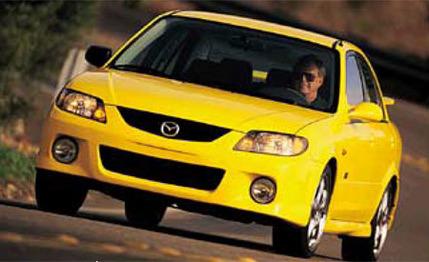 First Drive Review
First Drive Review
Although Mazda is in the midst of an image makeover designed to portray the company as a purveyor of sporting machinery -- you've seen the "zoom-zoom" commercial, right? -- the truth is there is not yet a lot of substance behind the smoke and mirrors. Hey, we like the Miata as much as anyone else. But it takes more than one small roadster to legitimize the notion of Mazda as Fun-to-Drive Central.
And that's what this car is all about. MPS stands for Mazda Performance Series, and the Protegé concept was first shown at last year's SEMA show in Las Vegas and is now on the verge of limited production. In addition to giving the New Age SoCal hot rodders an alternative to Honda Civics and Acura Integras, the MPS represents Mazda's first step into a realm once owned by Nissan: four-door sports-car turf.
We liked the concept we saw in Vegas. And we liked it even better when Mazda invited us to take a spin in a prototype whose next stop was the Detroit show. The idea of this exclusive first drive was to provide some feedback on the project: Small performance sedans represent uncharted waters for Mazda. And that's exactly what we'll do here -- as soon as we've cataloged the elements that separate the Protegé MPS from the standard 2001 Protegé ES.
Recognizing Mazda's relative inexperience in the small-hot-rod realm, project leader Kelvin Hiraishi turned to Racing Beat for expert help in developing the car's suspension, which, as it turns out, is what the MPS is all about. Since opening its Anaheim shops in 1971, Racing Beat has been a major go-faster source for owners of rotary-powered Mazdas and, more recently, Miatas. Hiraishi's project was handled by Racing Beat principal Jim Mederer. Mederer in turn worked first with Koni and ultimately Tokico to get the right dampers and is quick to credit both Mazda and the Tokico rep for the success of the finished product.
"The updated Protegé made a great starting point," he says. "It's a very good package. Mazda allowed us significant latitude for getting this right, and I can't say enough about this guy from Tokico. He really had a lot to do with the combination of refinement, control, and comfort. We're pretty pleased with it."
Besides the Tokico dampers, the suspension includes hardened bushings, heavier front and rear anti-roll bars (25 and 21 millimeters vs. the stock 21 and 16mm), and a 15mm reduction in static ride height. The steering system employs a Euro-spec Protegé steering rack, and a set of Z-rated 205/45 Dunlop SP2000 tires, on 7.0-by-17-inch Racing Hart alloy wheels, transmits the driver's inputs to the pavement.
Transmits them with authority, we might add. Every element of this car's dynamic profile is more decisive than the standard Protegé ES, no slouch in its own right. The MPS attacks corners with the enthusiasm of a Miata and not much more body roll. It's quick on its feet, its steering communicates every nuance of angle, its cornering limits seem substantially higher, and it seems to manage all this without too much compromise in ride quality and interior noise.
Mazda has summoned a little more thrust to go with all this extra agility, but not much. Massaging the combustion program, intake manifold, and ignition timing, plus a very mellifluous Racing Beat muffler, yields a modest bump in torque and horsepower of the 2.0-liter four. Mazda hadn't finalized the output numbers at press time, but the semiofficial estimate is for 140 horsepower and 140 pound-feet of torque.
We were unable to run formal acceleration tests during our brief stint, but we'd guess the MPS will be able to get to 60 mph in the low-eight-second range.
Naturally, there's cosmetic distinction. Besides the wheels, the MPS gets a more aggressive front fascia and rocker-panel extensions, although these will be shared with the Protegé 5 hatchback. The rear wing is unique to the MPS, though, and silver leather brightens up the seats and three-spoke steering wheel. The aluminum-clad foot pedals are from Sparco, and there's also a jazzy-looking 280-watt Kenwood Excelon audio system with buttons that seem to be designed for a PalmPilot stylus.
All in all, it's a conservative package, with several unknowns. Price, for example. Mazda will say only "less than $20,000." We'd guess at least $1000 under that. It was also unclear whether the car will be called MPS.
But one thing is clear, at least to us: The Protegé MPS will quickly endear itself to anyone who takes pleasure in switchbacks, decreasing-radius turns, and fast S-bends. It may not generate nosebleeds. But it's our kind of zoom-zoom nonetheless.